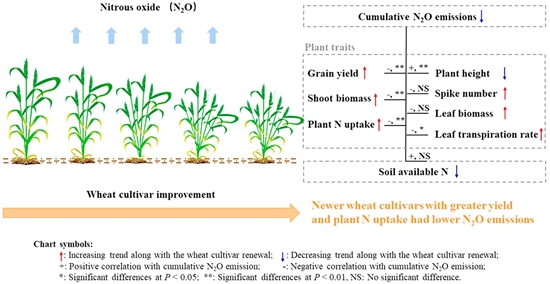Scientists from ICS Reveal the Higher Yield with Lower N2O Emissions of Newly-released Winter Wheat Varieties
The Innovation Team of Farming System and Agro-Ecology, Institute of Crop Sciences, Chinese Academy of Agricultural Sciences (ICS-CAAS), demonstrated the characteristics and biological mechanisms of high-yielding winter wheat varieties with less nitrous oxide (N2O) emissions based on the field experiments. This research has been published in Agriculture, Ecosystems and Environment recently, which is another important finding revealed by the team following high-yielding modern rice varieties with low methane emissions.
According to the team leader Dr. Zhang Weijian, food security is the primary goal of crop production, while Carbon Peak and Carbon Neutrality are also important parts which need to be considered in the current and future crop productions of China. Wheat is the second-largest staple food in China and wheat field is also a main emission source of N2O. Meanwhile, N2O is the third most important greenhouse gas (GHG). It is essential to find a synergistic approach to reduce N2O emissions while maintaining or increasing crop yield for achieving food security and GHG mitigation.
The study demonstrates that the morphological and physiological characteristics of wheat have changed greatly with the improvement of winter wheat varieties in China. Newly-released winter wheat varieties generally achieve high productivity and strong root absorption capacity. These characteristics could increase the utilization of soil nitrogen by plants and, consequently, decrease nitrogen availability for N2O emissions. Through multi-species comparison in the fields, this research also found that grain yield increased by 6.8% per decade, and nitrogen absorption of winter wheat increased simultaneously with the variety improvement. In addition, the cumulative and yield-scaled N2O emissions from the winter wheat field decreased by 2.0% and 8.9% per decade, respectively. N2O emissions negatively correlated with crop nitrogen absorption capacity. This research contributes significantly to build up basic knowledge for wheat cultivar selection and agronomic management innovation to achieve higher yield and reduce N2O emissions from winter wheat fields.
This work is first-authored by Dr. Chen Huan, who graduated from ICS-CAAS. Dr. Zhang Weijian and Dr. Cao Chengfu are co-corresponding authors. The research was supported by National Key Research and Development Program of the 13th Five-Year plan and the Science and Technology Innovation Project of CAAS.

Reference resource: https://www.sciencedirect.com/science/article/pii/S0167880921002619
By Zhang Weijian (zhangweijian@caas.cn)
-
 Apr 18, 2024Opening Ceremony of the Training Workshop on Wheat Head Scab Resistance Breeding and Pest Control in Africa Held in CAAS
Apr 18, 2024Opening Ceremony of the Training Workshop on Wheat Head Scab Resistance Breeding and Pest Control in Africa Held in CAAS -
 Apr 03, 2024IPPCAAS Co-organized the Training Workshop on Management and Application of Biopesticides in Nepal
Apr 03, 2024IPPCAAS Co-organized the Training Workshop on Management and Application of Biopesticides in Nepal -
 Mar 28, 2024Delegation from the School of Agriculture and Food Science of University College Dublin, Ireland Visit to IAS, CAAS
Mar 28, 2024Delegation from the School of Agriculture and Food Science of University College Dublin, Ireland Visit to IAS, CAAS -
 Mar 25, 2024Director of World Food Prize Foundation visited GSCAAS
Mar 25, 2024Director of World Food Prize Foundation visited GSCAAS -
 Mar 20, 2024Institute of Crop Sciences (ICS) and Syngenta Group Global Seeds Advance Collaborative Research in the Seed Industry
Mar 20, 2024Institute of Crop Sciences (ICS) and Syngenta Group Global Seeds Advance Collaborative Research in the Seed Industry
